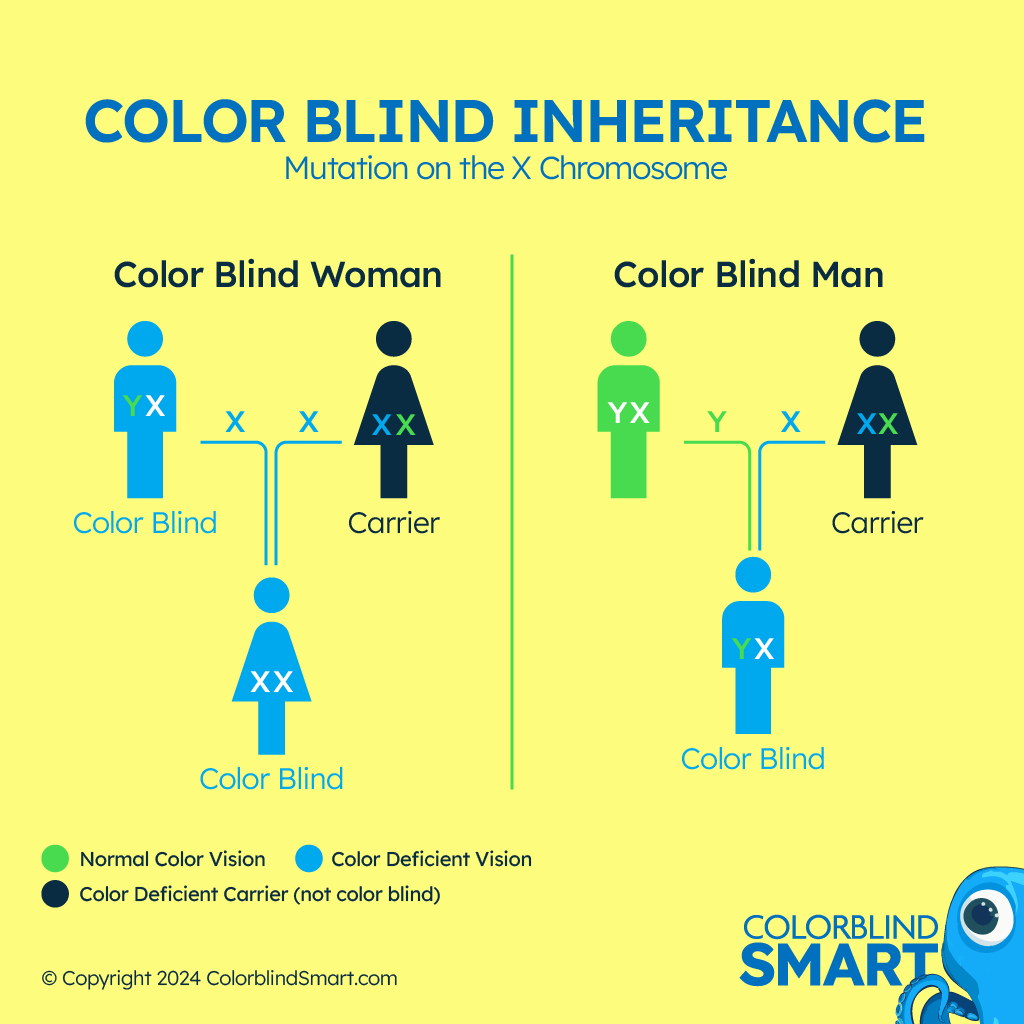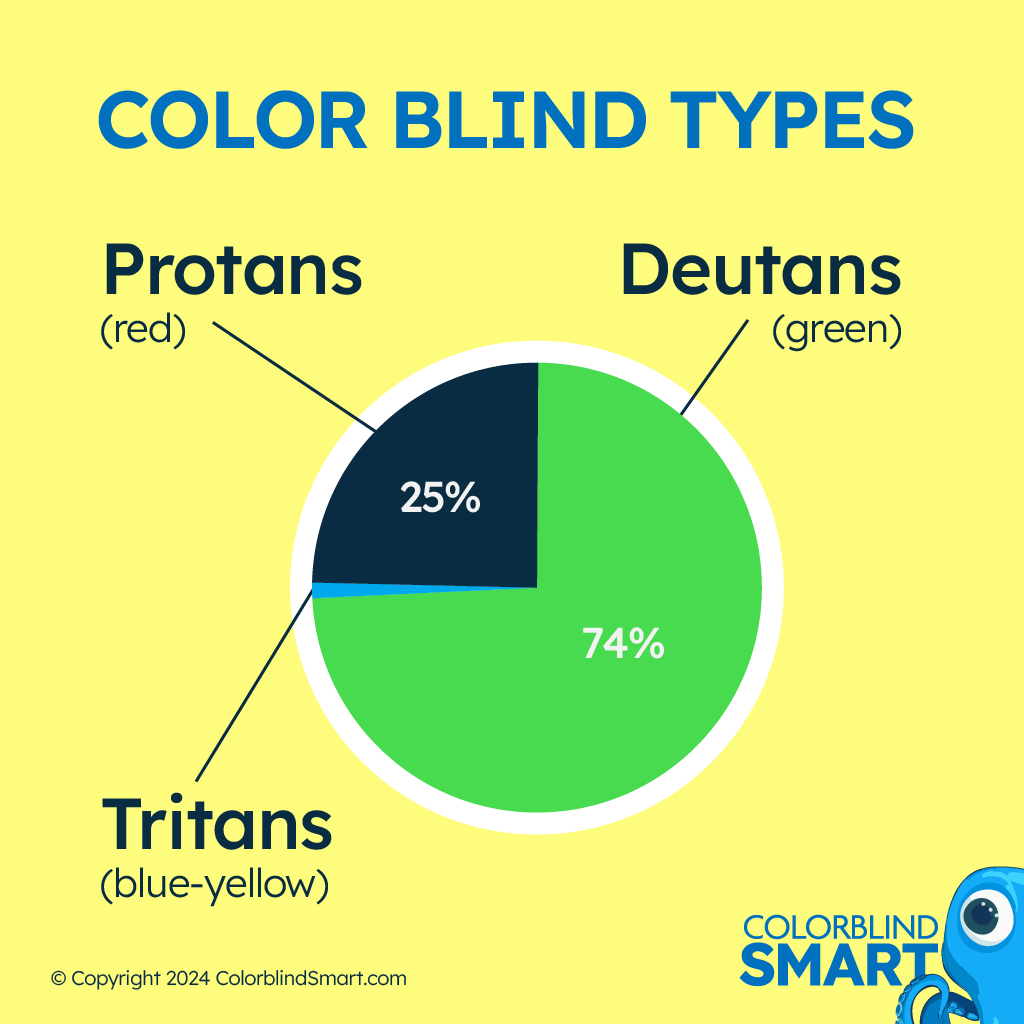How Is Color Blindness Inherited?
Her two sons’ color blindness came out of nowhere. She didn’t know anyone else in her family that had it. She was my mother. Learn how this inheritance pattern can happen!

Understanding the Inheritance Pattern of Color Blindness
Color blindness, also called color vision deficiency, alters how some people perceive colors in daily life. Many assume it means seeing no color at all, but most cases only limit the ability to distinguish certain hues. While it’s common to hear about red-green color blindness, other forms involve difficulties with blue-yellow or, in rare cases, very little color perception. Learn how color blindness is inherited, the typical genetic patterns, and how it can unexpectedly “appear” in families like mine.
What Is Color Blindness?
Color blindness occurs when the cone cells in the retina—responsible for detecting red, green, or blue light—don’t function as they should. These cones rely on genes that produce light-sensitive pigments. When a gene is mutated, the affected cone responds incorrectly or not at all. Key types of color blindness include:

- Red-Green Deficiency (Deutan/Protan)
By far the most prevalent, divided into protan (red cone deficiency) and deutan (green cone deficiency). People with protan deficiencies might see reds as dark or dull, while deutan deficiencies can make greens hard to distinguish from reds or browns. - Blue-Yellow Deficiency (Tritan)
Less common, this affects how the eyes differentiate blue from green and yellow from white or gray. - Complete Color Blindness (Achromatopsia)
Very rare. Individuals see mainly shades of gray and often experience extreme light sensitivity.
My brother and I are deutans (green color blindness) which is the most common type. It can impact everyday tasks such as reading traffic lights, picking out produce, or recognizing color-coded warnings. I’ve found ways to work around these issues, and I now understand the inheritance pattern so let’s clear up any confusion about why it occurs.
How Is Color Blind Inherited?
Most inheritance patterns of color blindness revolve around genes on the X chromosome. Males have one X chromosome (from their mother) and one Y chromosome (from their father). If the X they receive carries a defective color vision gene, like mine did, they inherit color blindness because they lack a second X chromosome to compensate. Females have two X chromosomes—one from each parent. If only one X has the mutation, they won’t be color blind themselves, thanks to the other healthy X.

X-Linked Basics
- Mother Is a Carrier, Father Is Unaffected
My brother and I both had a 50% chance of inheriting the mutant X and becoming color blind.
A daughter has a 50% chance of carrying the gene without showing major symptoms, unless she also inherits a faulty X from her father. - Father Is Color Blind, Mother Is Unaffected
My daughter is a carrier (they inherit their father’s affected X).
My sons inherited my Y chromosome, so they’re not color blind from my side of the family. - Father Is Color Blind, Mother Is a Carrier or Color Blind
A daughter may inherit the faulty X from both parents, making her color blind.
Sons have a high chance of being color blind if they receive the mother’s defective X.
These patterns explain why color blindness affects many more males (around 8%) than females (around 0.5%). A mother who carries the gene can pass it to her children without showing any color vision problems herself.
Other Inheritance Patterns
While most red-green deficiencies follow an X-linked model, a small number—particularly some blue-yellow deficiencies—can follow autosomal (non-sex chromosome) patterns. In such rare cases, both males and females have an equal chance of inheriting and showing color blindness. Additionally, color blindness doesn’t always arise from inheritance:
- Acquired Color Blindness
Certain eye diseases, injuries, or medication side effects may damage cone cells or the optic nerve. These causes are not linked to family history or the X chromosome. - New Mutations
There are a small number of documented cases where a genetic mutation showed up for the first time in a family with no previous record of color blindness. This “new mutation” could then be passed to future generations.
Examples and Family Scenarios
Color blindness can sometimes appear in a child even though neither parent is color blind. This can happen if the mother is a carrier who inherited a mutated gene from her father. Because she isn’t color blind herself (her other X chromosome compensates), the trait remains hidden until she has a son who receives the defective X. This phenomenon makes it look as though color blindness “came out of nowhere.”
Skipping Generations
Imagine a grandfather who’s color blind on the mother’s side. His daughter (the mother in the next generation) isn’t color blind but carries his faulty gene on one of her X chromosomes. If she marries a man with normal color vision, each son has a 50% chance of inheriting that faulty X, revealing color blindness once again. Each daughter also has a 50% chance of carrying it on silently.
Appearing Out of Nowhere
In some families, there may be no known color-blind relatives, yet a child is diagnosed. A few possible explanations:
-
A Carrier Mother
It’s possible prior generations had mild cases or seldom got tested. -
A Carrier Mother and Carrier Grandmother
This is what happened in my family. We suspect that my great grandfather was color blind, and maybe he wasn’t even aware of it. But my grandfather was not so my grandmother must have passed the carrier gene to my mom who passed the gene to me.
Passing It On When a Boy Is Color Blind
When a boy grows up color blind and later has children, the inheritance pattern can be confusing, but follows the same principles. I have one daughter and sons so here are the scenarios for each.
- If He Has a Daughter
That daughter receives his affected X chromosome, making her a carrier (unless her mother also contributes a faulty X, which could result in the daughter being color blind).
As a carrier, she could pass it to her own sons or daughters, continuing the cycle. - If He Has a Son
The son inherits his father’s Y chromosome, so the father’s color blindness doesn’t pass directly this way.
The son’s color vision status then depends on the mother’s X chromosomes.
In this way, a color-blind male can have grandsons who are color blind through his daughter(s) if they inherit his affected X chromosome. Each grandson from a carrier daughter again has that 50% risk. This is what happened to my sister’s son. She got the carrier gene from my mom and then passed it on to her son.
Multiple Generations of Color Blindness
In some families, color blindness persists in nearly every male generation. This might happen if female carriers consistently pass the gene along to sons, and those sons later have daughters who carry it forward. Though not guaranteed, this repeating pattern is common when the gene remains in a family line with multiple sons.
FAQs
- Can color blindness skip generations?
Yes. A carrier mother may not show symptoms, yet she can pass the gene to a son who then becomes color blind. It can seem to “skip” until it’s expressed in a male child. - Why aren’t more women color blind?
Women have two X chromosomes, so they need mutations in both to show pronounced color blindness. Receiving only one defective X usually leads to carrier status without major color vision issues. - What if no one in our family is color blind but my child is?
It could be a hidden carrier situation or a new mutation. Genetic testing can confirm whether the child has an inherited or spontaneous change. - Do color-blind men pass it directly to their sons?
No. Sons get their father’s Y chromosome. However, the father’s color-blind X can go to daughters, who can become carriers or color blind if their mother also provides a faulty X.
The inheritance pattern of color blindness hinges on the X chromosome, which explains why more males are affected and why color blindness may “skip” generations. Sometimes it seems to appear unexpectedly due to carrier mothers or brand-new mutations like it did in my family.
Whether it appears in a grandson after lying dormant in a carrier daughter or persists through repeated generations, color blindness follows clear genetic rules. Recognizing how color blindness is inherited helps families spot carriers, plan for testing, and better understand why the condition resurfaces—or emerges unexpectedly—across different branches of a family tree.
Last updated: April 04 2025